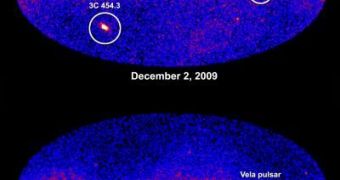Blazars, also called blazing quasi-stellar objects, are very compact quasars that are usually believed to exist in association with supermassive black holes. The structures can only be found in the active nuclei of giant elliptical galaxies, and are widely regarded as one of the most brutal and impressive phenomena in the entire Universe. They are studied extensively as a topic in extragalactic astronomy, and are also the target for observatories such as NASA's Fermi Gamma-ray Space Telescope. Recently, the instrument managed to gather data on the brightest blazar ever to have been spotted.
The recently discovered structure lies about 7.2 billion light-years away, in the direction of the constellation Pegasus. This means that it is located about halfway through the vast reaches of space, and was formed when the Universe was about half its current age. The blazar lies at the core of a very active galaxy, but stands out through the massive outbursts it produces. Astronomers, who dubbed the structure 3C 454.3, say that outshining other blazars so strongly is not an easy feat, and that the new celestial object must truly be special.
“We're looking right down the barrel of a particle jet powered by the galaxy's supermassive black hole. Some change within that jet - we don't know what – is likely responsible for these flares,” Perugia, Italy-based National Institute of Nuclear Physics expert GinoTosti explains. The expert adds that the flaring up began on September 15, and that it has constantly grown in size ever since. As such, 3C 454.3 is now about ten times as bright as it was this summer, the group reports. Each blazar, the experts add, emits two opposite-direction jets of radiation from its core, and the reason why we can see these ones is that one of them is aimed straight at us.
Normally, the Vela pulsar, located a mere 1,000 light-years away, is the most powerful source of gamma-ray radiation we see. “3C 454.3 is millions of times farther away, yet the current flare makes it twice as bright as Vela. That represents an incredible energy release, and one the source can't sustain for very long,” scientist Lise Escande says. She is based at the Center for Nuclear Studies, in Gradignan, France. “In red light, the blazar brightened by more than two and a half times to magnitude 13.7, and it is also very bright at high radio frequencies,” Torino Observatory astronomer Massimo Villata adds.

 14 DAY TRIAL //
14 DAY TRIAL //